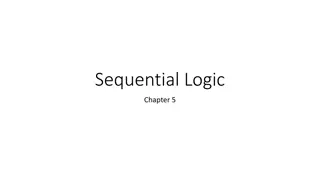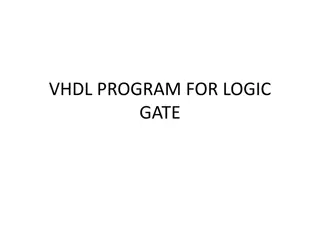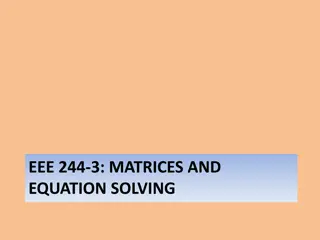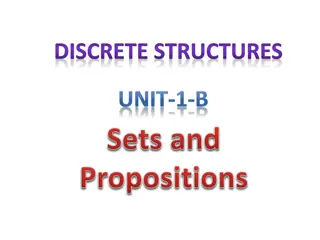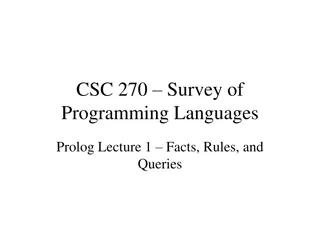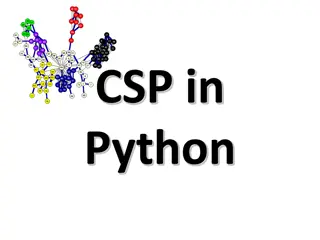Prolog Mini-Exercises: Solving Logic Problems
Explore the world of Prolog through a series of mini-exercises that demonstrate solving logic problems using different predicates and efficient techniques like cuts. The exercises cover topics such as membership checking, efficient list manipulation, and understanding the behavior of Prolog predicates.
Download Presentation

Please find below an Image/Link to download the presentation.
The content on the website is provided AS IS for your information and personal use only. It may not be sold, licensed, or shared on other websites without obtaining consent from the author.If you encounter any issues during the download, it is possible that the publisher has removed the file from their server.
You are allowed to download the files provided on this website for personal or commercial use, subject to the condition that they are used lawfully. All files are the property of their respective owners.
The content on the website is provided AS IS for your information and personal use only. It may not be sold, licensed, or shared on other websites without obtaining consent from the author.
E N D
Presentation Transcript
Prolog 11-19-2015
Mini-exercise What are all the answers that Prolog returns for the following goals? ?- member_cut(X,[c,b,r]), mymember(X,[r,b]). ?- mymember(X,[r,b]), member_cut(X,[c,b,r]). ?- member_cut(X,[c,b,r]), member_cut(X, [b,c]).
Mini-exercise What are all the answers that Prolog returns for the following goals? ?- member_cut(X,[c,b,r]), mymember(X,[r,b]). false. ?- mymember(X,[r,b]), member_cut(X,[c,b,r]). X = r ; X = b ; false. ?- member_cut(X,[c,b,r]), member_cut(X, [b,c]). X = c ;
Mini-exercise #2 4. What are all the answers that Prolog returns for the following goals? ?- not(mymember(1,[1,2,3])). ?- not(mymember(5,[1,2,3])). ?- not(mymember(X,[1,2,3])). ?- mymember(X,[1,2,3]), not(mymember(X,[1,2,4])). ?- not(mymember(X,[1,2,4])), mymember(X,[1,2,3]).
Mini-exercise #2 4. What are all the answers that Prolog returns for the following goals? ?- not(mymember(1,[1,2,3])). false. ?- not(mymember(5,[1,2,3])). true. ?- not(mymember(X,[1,2,3])). false. ?- mymember(X,[1,2,3]), not(mymember(X,[1,2,4])). X = 3 ; false. ?- not(mymember(X,[1,2,4])), mymember(X,[1,2,3]). false.
Mini-exercise #2 5. Consider the standard version of append: append([],Ys,Ys). append([X|Xs],Ys,[X|Zs]) :- append(Xs,Ys,Zs). If you know that the first argument is ground (that is, fully instantiated, containing no variables), there is a more efficient version that you can write by including a cut. (a) Define such a version. (b) Give an example of a query that has exactly the same behavior for both the standard version and the version with a cut.
Mini-exercise #2 5. Consider the standard version of append: append([],Ys,Ys). append([X|Xs],Ys,[X|Zs]) :- append(Xs,Ys,Zs). If you know that the first argument is ground (that is, fully instantiated, containing no variables), there is a more efficient version that you can write by including a cut. (a) Define such a version. append([],Ys,Ys) :- !. append([X|Xs],Ys,[X|Zs]) :- append(Xs,Ys,Zs). (b) Give an example of a query that has exactly the same behavior for both the standard version and the version with a cut. append([1,2],[3,4,5],X).
Mini-exercise #2 5. Consider the standard version of append: append([],Ys,Ys). append([X|Xs],Ys,[X|Zs]) :- append(Xs,Ys,Zs). If you know that the first argument is ground (that is, fully instantiated, containing no variables), there is a more efficient version that you can write by including a cut. (c) Give an example of a query that behaves differently for the standard version and the version with a cut (d) What restrictions do we need on the inputs for the two versions to behave exactly the same? (Is it that the first argument is ground?)
Mini-exercise #2 5. Consider the standard version of append: append([],Ys,Ys). append([X|Xs],Ys,[X|Zs]) :- append(Xs,Ys,Zs). If you know that the first argument is ground (that is, fully instantiated, containing no variables), there is a more efficient version that you can write by including a cut. (c) Give an example of a query that behaves differently for the standard version and the version with a cut append(A,B,[1,2,3]). (d) What restrictions do we need on the inputs for the two versions to behave exactly the same? (Is it that the first argument is ground?) No, it s a little more general: just that the first argument not be a variable.
Mini-exercise #2 6. Which of the following lists represent valid difference lists? For valid difference lists, what list do they represent? [1,2|T]\T -- [1,2,3]\[] -- [1,2,3]\[1,2] -- [1,2,3|T]\[3|T] -- [1,2,3]\[1,2,3] --
Mini-exercise #2 6. Which of the following lists represent valid difference lists? For valid difference lists, what list do they represent? [1,2|T]\T -- valid, represented [1,2] [1,2,3]\[] -- valid, represents [1,2,3] [1,2,3]\[1,2] -- not valid [1,2,3|T]\[3|T] -- valid, represents [1,2] [1,2,3]\[1,2,3] -- valid, represents []
Mini-exercise #2 7. Write the list [squid,clam] as a difference list (in the most general possible way). Also draw a box-and-arrow diagram of the first part of the difference list.
Mini-exercise #2 7. Write the list [squid,clam] as a difference list (in the most general possible way). Also draw a box-and-arrow diagram of the first part of the difference list. [squid,clam|T]\T ____________ | | | | | o | ---- |-----> | |_ |__ |_____ | |_ | | squid ____________ | | o |__ |_____ | T | | | | clam



